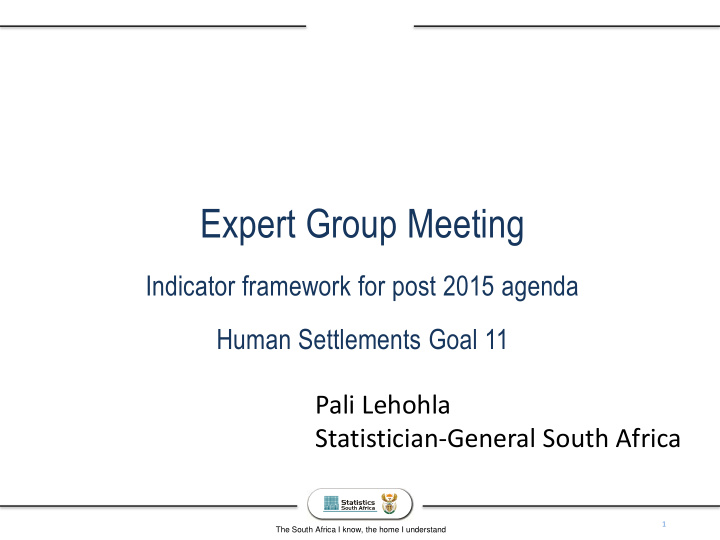



Expert Group Meeting Indicator framework for post 2015 agenda Human Settlements Goal 11 Pali Lehohla Statistician-General South Africa 1 The South Africa I know, the home I understand
Presentation scheme Policy Perspectives on Human Settlements Instruments for policy implementation Assessment of policy implementation Indicators The need for global agreements The South Africa I know, the home I understand
Policy Perspectives on Human Settlements the National Development Plan (NDP) places emphasis on: “Transforming human settlements and the national space economy” “… by 2030 South Africa should observe meaningful and measurable progress in reviving rural areas and in creating more functionally integrated… urban settlements” Investment in PEOPLE (capabilities, education, health); ECONOMY (growth & job creation), PLACES (social integration, access to opportunities) The South Africa I know, the home I understand
Instruments for policy implementation In 1994, the SA Government inherited an urban form which was spatially segregated, socially fragmented & economically marginalised Government responded with various legislation, policies, strategies - • Integrated Development Plans • Spatial Development Framework • Capital Investment Framework • Built environment Plans (transport, roads, infrastructure investments, human settlements) • Service sector plans (develop small business economies) • Spatial Planning and Landuse Management Act • Municipal Systems Act The South Africa I know, the home I understand
Assessment of policy implementation Despite policy mechanisms, and significant investment in infrastructure and service delivery, there is widespread consensus that: • Spatial Development policies has to a large extent failed to achieve the desired spatial outcomes • The inherited spatial patterns of the apartheid era remains firmly entrenched • Spatial fragmentation of settlements, with resulting inefficiencies, remains • The distribution of population and resources continues to become more inequitable The South Africa I know, the home I understand
2006 Number of buildings completed 2013 In both 2006 and 2013, Cape • Census data shows large metros Town and Tswhane completed the attract. most number of buildings • Building Plan data shows continuous unattractiveness of most municipalities/ places in SA. Why? The South Africa I know, the home I understand
Municipal Capital Investment Framework & Spatial Development Frameworks Census 2001 Population Census 2011 Population • Strengthen intergovernmental & long-term planning. • Capital investment spending must be aligned with spatial development planning. • Evidence-based policy decisions. Greater analytical capabilities. Build statistical intelligence (data from various sources). Planning, monitoring & evaluating statistical infrastructure/ frameworks. Address the small-area information gap between censuses. • Redevelop townships (health, education, transport, economic opportunities) • Strengthen the economic role of municipalities/ places. • Develop viable infrastructure to link with rural places. Public Capital Spending
Indicators ENVIRONMENT (Built and natural environments, un-used land, spatial re- structuring, etc.) Socio- demographic ECONOMY (Population densities, (Growth, employment, basic services – water, industries, capital electricity demand, investments, etc.) education, health, safety, recreational, Government services, etc.) • Requires measuring ‘bottom - up’ within the place/ neighbourhood/ community/ wards • Requires strong institutions (local municipalities, districts, cities & provinces) The South Africa I know, the home I understand
Recommend
More recommend